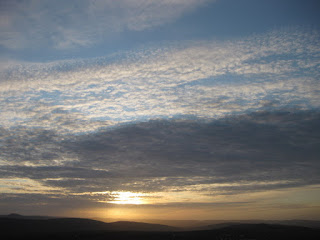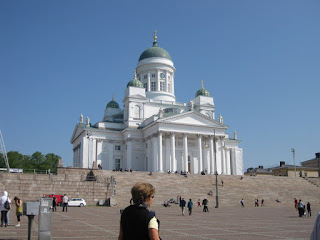 Mainly this week I have perspired and swatted vexatious insects. These pursuits, judging by the weather forecast, will continue to be my main activities for the foreseeable. Jones says that I wouldn’t feel so hot if I didn’t think about it.
Mainly this week I have perspired and swatted vexatious insects. These pursuits, judging by the weather forecast, will continue to be my main activities for the foreseeable. Jones says that I wouldn’t feel so hot if I didn’t think about it. Well, it’s hard not to think of being hot when there’s a stream of perspiration running into your eyes and down your neck. As it happens, I can tell how hot it is by the number of pit-stops I make on our morning walk. In high summer I can complete our circuit with nary a pause. In winter, hardly a bush is spared.
This week we have stuck to a shorter circuit on the advice of the vet who snipped the two pups last Monday. To our great relief, he used a new micro-surgical technique on Mary, eliminating the need for the miserable lampshade collar that prevents pets post-op from getting at the wound. The following day she was understandably subdued but by Wednesday she was full of beans once again.
 Russ, beyond a brief loss of appetite, hardly seemed to notice the small incision he suffered. While they were under anaesthetic, both pups were micro-chipped, as is now required by law.
Russ, beyond a brief loss of appetite, hardly seemed to notice the small incision he suffered. While they were under anaesthetic, both pups were micro-chipped, as is now required by law. Also Monday, we went into Faro to hand in my ailing smart-phone to the repair shop. “About ten days” said the young man who noted down its symptoms. In the meanwhile, having lent out my spare mobile, I am reduced to using the bare-bones guest phone.
This is Nokia’s starter model, not that any status-conscious child would be seen dead with it. The phone costs the same as a replacement battery, which tells you something. Using it feels like going back to the horse and cart. The predictive dictionary offers the user bursts of a mandarin-like gobbledegook that suggest the origins of the phone itself.
 Tuesday we went to the notary to complete our purchase of the ruin on the adjacent land that we acquired earlier this year. All went well until our lawyer asked me for the print-outs of the tax payments that must be made before a property can be sold. Details of the payments have to be noted on the deed.
Tuesday we went to the notary to complete our purchase of the ruin on the adjacent land that we acquired earlier this year. All went well until our lawyer asked me for the print-outs of the tax payments that must be made before a property can be sold. Details of the payments have to be noted on the deed. I had to confess ruefully that I hadn’t brought them. Fortunately for me, I’d made the payments online and was able to use the secretary’s computer to access my bank account and print off the references. Even so, I’m still kicking myself.
Wednesday is Russian day.
 Natalia comes for 90 minutes of English and Natasha (a name that is actually the familiar form of “Natalia”) comes to clean. I fetch the latter from the bus in Benafim. If truth be told, she would rather be driving herself in her newly-acquired Nissan Almera but the car is playing up.
Natalia comes for 90 minutes of English and Natasha (a name that is actually the familiar form of “Natalia”) comes to clean. I fetch the latter from the bus in Benafim. If truth be told, she would rather be driving herself in her newly-acquired Nissan Almera but the car is playing up.At the end of the afternoon I took her around to a workshop near Loule to see if the problem had been fixed. It hadn't. The replacement part that the garage had installed hadn’t done the trick, she learned, and another part would be necessary. All that’s clear to Natasha is that car ownership is proving more expensive than she anticipated. We could have told her that.
From the workshop we proceeded to the house of elderly friends of ours for whom Natasha cleans. Her duties include tending the pool, which needed to be emptied before her other half, Slavic, arrived to scrub it down the following day. While Natasha was familiar with the filtering and back-washing procedures, she’d never emptied the pool – nor were there instructions on how to do so. Having looked after our pool at the Quinta, I was able to set things up for Slavic.
 Jones, as well as tending her ever-demanding garden, has been preparing for the arrival of her nephew and family this weekend, as well as extended family early next week. One of her tasks has been to clean the Bijou Ensuite. On removing a drawer, she came across such a tribe of long-legged spiders as never you have seen before, dozens and dozens of them. Jones is not a squealer but for once in her life she squealed.
Jones, as well as tending her ever-demanding garden, has been preparing for the arrival of her nephew and family this weekend, as well as extended family early next week. One of her tasks has been to clean the Bijou Ensuite. On removing a drawer, she came across such a tribe of long-legged spiders as never you have seen before, dozens and dozens of them. Jones is not a squealer but for once in her life she squealed. Let me pause to tell you that while I merely vacuum up an unwanted arachnid, Jones traps the creature under a glass and frees it outside. With a nest of disturbed spiders, all fleeing every which way, such a tender approach is not feasible. She was reduced, much against her instincts, to vacuuming them up as hard as she could go – although, having sucked them all into the vacuum cleaner, she took the appliance outside and removed the bag; thereupon, the spiders poured out again like souls freed from hell. It was astonishing to watch.
Let me pause to tell you that while I merely vacuum up an unwanted arachnid, Jones traps the creature under a glass and frees it outside. With a nest of disturbed spiders, all fleeing every which way, such a tender approach is not feasible. She was reduced, much against her instincts, to vacuuming them up as hard as she could go – although, having sucked them all into the vacuum cleaner, she took the appliance outside and removed the bag; thereupon, the spiders poured out again like souls freed from hell. It was astonishing to watch. My part in the Bijou Ensuite preparations was to install certain objects in the bathroom. We’d bought the necessary at a hardware store the previous week but they’d disappeared without trace. In vain we searched high and low. Jones then recalled that I’d nipped into a phone store while carrying the purchases to the car. Back I went to inquire - all of a week later. The lass behind the desk was pleased to return the objects, which I have since fastened into place.
My part in the Bijou Ensuite preparations was to install certain objects in the bathroom. We’d bought the necessary at a hardware store the previous week but they’d disappeared without trace. In vain we searched high and low. Jones then recalled that I’d nipped into a phone store while carrying the purchases to the car. Back I went to inquire - all of a week later. The lass behind the desk was pleased to return the objects, which I have since fastened into place. I am summoned downstairs for final guest preparations. The cobbles must be swept and boys' beds made. (I sure hope the dogs don't mind the guests sharing their patio.) Then the floor tiles must be vacuumed and mopped. The whole place has to gleam. It's a good thing I'm not in charge of the welcome desk.
I am summoned downstairs for final guest preparations. The cobbles must be swept and boys' beds made. (I sure hope the dogs don't mind the guests sharing their patio.) Then the floor tiles must be vacuumed and mopped. The whole place has to gleam. It's a good thing I'm not in charge of the welcome desk.


















































